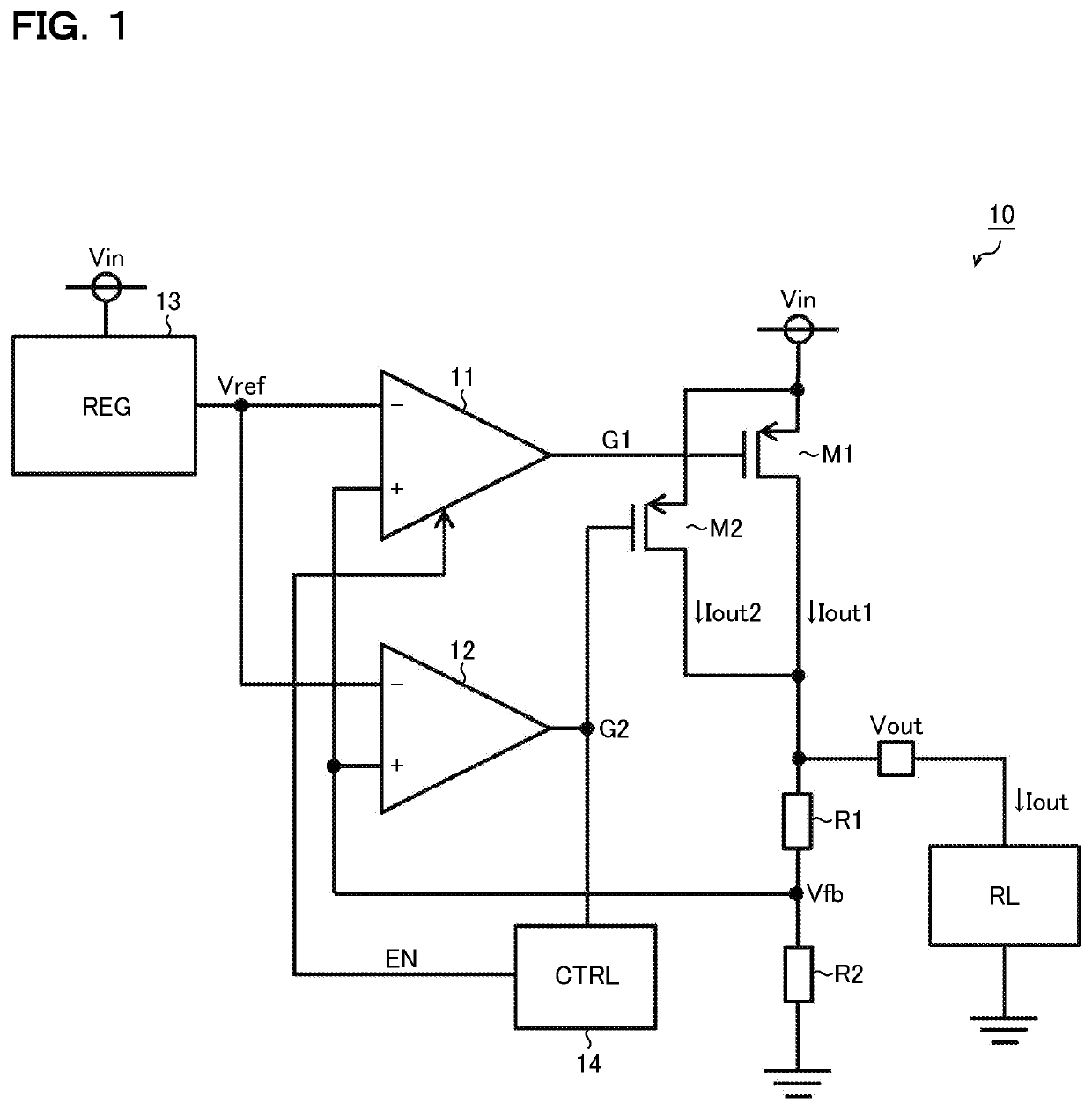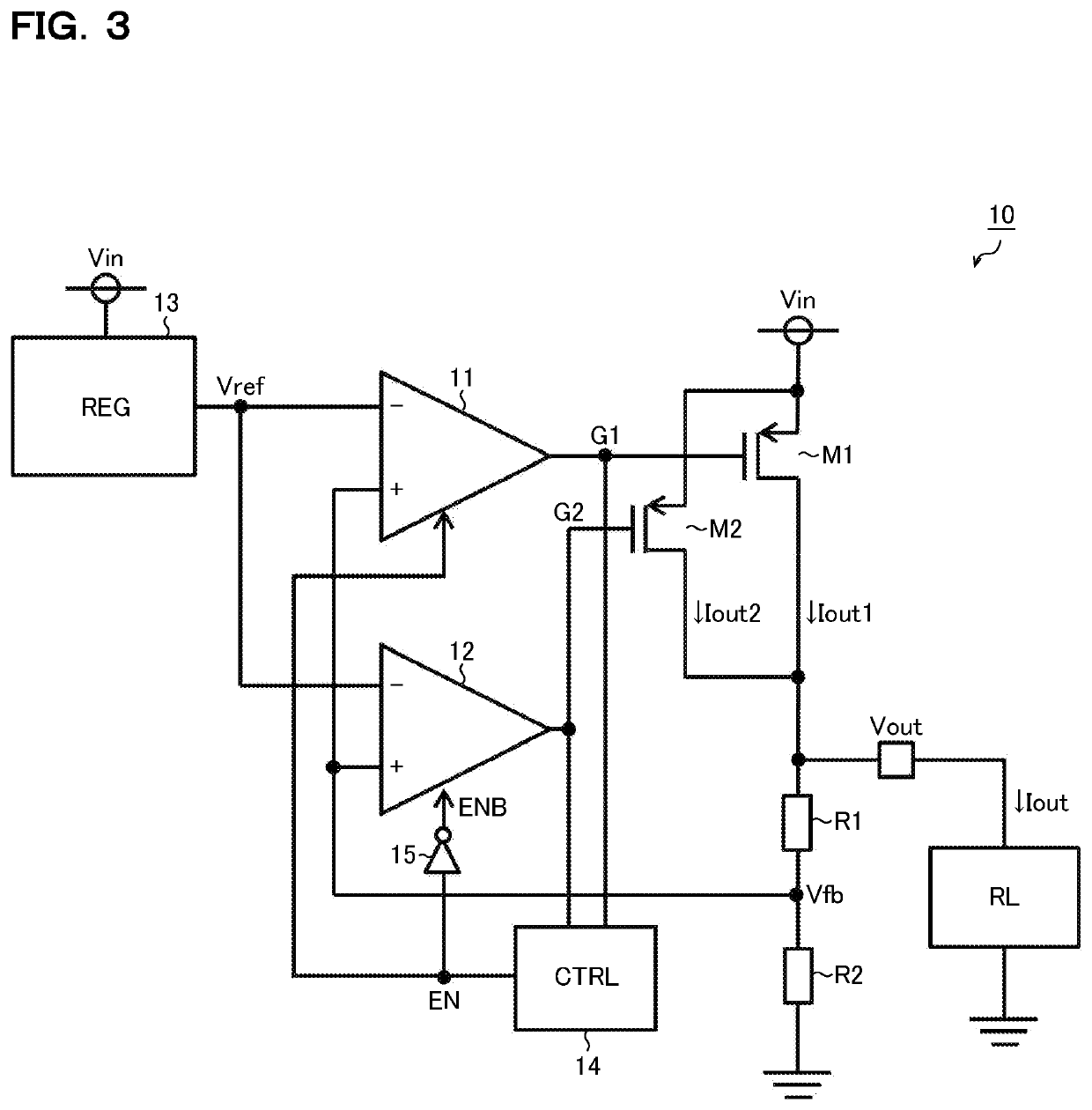Series regulator including parallel transistors
a technology of parallel transistors and regulators, applied in the direction of electric variable regulation, process and machine control, instruments, etc., can solve the problems of difficult to achieve stable operation in a wide load range and fast load response, and achieve stable operation and fast load response , the effect of wide load rang
- Summary
- Abstract
- Description
- Claims
- Application Information
AI Technical Summary
Benefits of technology
Problems solved by technology
Method used
Image
Examples
first embodiment
[0031]FIG. 1 is a diagram showing a series regulator according to a first embodiment. The series regulator 10 of this embodiment is a semiconductor integrated circuit device (series power supply IC) that includes operational amplifiers 11 and 12, a reference voltage source 13, an amplifier control circuit 14, p-channel MOS (metal-oxide-semiconductor) field-effect transistors M1 and M2, and registers R1 and R2. The series regulator 10 generates from an input voltage Vin a desired output voltage Vout (=[(R1+R2) / R2]×Vref) to feed it to a load RL.
[0032]Instead of being integrated into the semiconductor integrated circuit device, the transistors M1 and M2 and the resistors R1 and R2 may be configured as externally connected discrete parts.
[0033]The transistor M1 is an output transistor for a heavy load. The source of the transistor M1 is connected to a power source (that is, the input terminal of the input voltage Vin). The drain of the transistor M1 is connected to the load RL (that is,...
second embodiment
[0047]FIG. 3 is a diagram showing a series regulator according to a second embodiment. The series regulator 10 of this embodiment, while being based on the first embodiment (FIG. 1), is modified such that the amplifier control circuit 14 does not only control whether or not to operate the operational amplifier 11 but also controls whether or not to operate the operational amplifier 12. To achieve that, the series regulator additionally includes an inverter 15. Accordingly, such components as have already been mentioned are identified by the same reference signs as FIG. 1, and no overlapping description will be repeated. The following description focuses on features unique to this embodiment.
[0048]The amplifier control circuit 14 checks, for example based on both the gate signals G1 and G2, whether the output current Iout is in the light-load region (IoutIth). The amplifier control circuit 14 then, based on the check result, generates the enable signal EN. Specifically, the amplifier...
third embodiment
[0059]FIG. 5 is a diagram showing a series regulator according to a third embodiment. The series regulator 10 of this embodiment, while being based on the second embodiment (FIG. 3), is modified such that the operational amplifier 12 does not keep the transistor M2 completely off even in the heavy-load region. In this embodiment, the inverter 15 is omitted, and separate enable signals EN1 and EN2 are fed from the amplifier control circuit 14 to the operational amplifiers 11 and 12 respectively.
[0060]The amplifier control circuit 14 checks, for example based on the gate signal G2, whether the output current Iout is in the light-load region (IoutIth). The amplifier control circuit 14 then, based on the check result, generates the enable signals EN1 and EN2. Specifically, the amplifier control circuit 14 generates the enable signals EN1 and EN2 so as to keep the operational amplifiers 11 and 12, in the light-load region, in the disabled state and in the enabled state respectively and, ...
PUM
 Login to View More
Login to View More Abstract
Description
Claims
Application Information
 Login to View More
Login to View More - R&D
- Intellectual Property
- Life Sciences
- Materials
- Tech Scout
- Unparalleled Data Quality
- Higher Quality Content
- 60% Fewer Hallucinations
Browse by: Latest US Patents, China's latest patents, Technical Efficacy Thesaurus, Application Domain, Technology Topic, Popular Technical Reports.
© 2025 PatSnap. All rights reserved.Legal|Privacy policy|Modern Slavery Act Transparency Statement|Sitemap|About US| Contact US: help@patsnap.com



